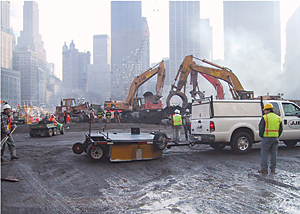 |
| PROBE Radar peers through streets around Trade Center. (Photo courtesy of ©Witten Technologies) |
Mapping and estimating the damage is the first phase of what is expected to be a two-year project for an eight-block area around the site of the Sept. 11 terrorist attacks.
Planning includes digging test pits to locate utility lines. GPR is helping determine where to dig to get the best information. "One of the problems is that there are no integrated maps," says Mike Oristaglio, chief scientist at Witten Technologies Inc., Boston, whose GPR system is being used. "Each utility maintains its own map, and the depth of the line almost never is indicated."
The Swedish province of Vasterbotten donated $150,000 to fund Witten’s contribution to creating 3D underground feature maps for New York City’s Dept. of Design and Construction. Malå GeoScience, headquartered in Malå, Vasterbotten, is the manufacturer of the hardware Witten’s system uses.
Manhattan-based consulting engineer Weidlinger Associates Inc. also is working on the project under subcontract to AMEC, New York City. Weidlinger is using traditional methods to collate data from various utility and government sources.
"There are no composite utility maps, some of the sources are dated and none of the plans are right," says Brian Wiprud, a Weidlinger utility specialist. Wiprud says the combination of the two approaches improves efficiency. GPR "gives us the ability to limit the number of test beds and lay them out more accurately," he says.
Wiprud acknowledges that there is often resistance to spending money for detailed pre-construction investigation because it is perceived as draining the budget while no apparent progress is made on the project. He says managers always find more money if they hit unexpected problems after breaking ground, but spending time and money to investigate conditions up front often is seen as the cause of delay, no matter how much it expedites work later on.
"The savings at the back end are not always apparent. People have to buy into it," Wiprud explains. More project-related information is at www.wittentech.com, and at www.malags.se.
round-penetrating radar is getting a workout in New York City during reconstruction of underground utilities near the World Trade Center.
Post a comment to this article
Report Abusive Comment